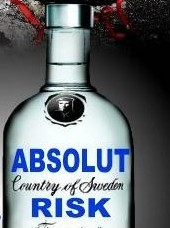At the next pharma love fest, spend some time with absolute risk

If relative risk is the guy that drug companies always want to have at the party, absolute risk is the guy who never gets invited, the total buzz kill, the guy who showed up with someone's cousin once in a bad outfit and ended up mumbling to himself in the corner about how everything would be better if people just listened to him.
Few do listen. Reporters, especially, fail to listen. They should, because they would find out that absolute risk can be invaluable in separating scientific breakthroughs from minor advancements from pure marketing puffery.
Absolute risk is a person's chance of developing a disease or a suffering an adverse event (like a heart attack) over time. The difference in risk in two populations – one that is taking the drug and one that is not (or is taking another drug) – is known as the absolute difference.
Gary Schwitzer at Health News Review explains the difference between relative risk and absolute risk with absolute clarity in his Tips for Understanding Studies.
Consider the risk for blindness in a patient with diabetes over a 5-year period. If the risk for blindness is 2 in 100 (2%) in a group of patients treated conventionally and 1 in 100 (1%) in patients treated with a new drug, the absolute difference is derived by simply subtracting the two risks: 2% - 1% = 1%. Expressed as an absolute difference, the new drug reduces the 5-year risk for blindness by 1%.
The relative difference is the ratio of the two risks. Given the data above, the relative difference is:
1% ÷ 2% = 50%
Expressed as a relative difference, the new drug reduces the risk for blindness by half.
Each is accurate. But if your job is marketing manager for the new drug, you are likely to only use the relative risk reduction. If your job is journalist, you would serve your readers and viewers better by citing the raw data and pointing out the absolute risk reduction. That's the "rest of the story" often missing in news releases and direct-to-consumer prescription drug ads.
Anne Harding at Reuters Health did a great job breaking down the difference between relative risk and absolute risk in a story about a study that tied being overweight as a child to a lower risk of breast cancer. (Ivan Oransky, Reuters Health executive editor, shared this example at the recent Association of Health Care Journalists conference in Chicago.)
Women who had larger bodies during childhood were 27 percent less likely to have breast cancer than women who were leaner as seven-year-olds. Being heavier as a girl was protective for all tumor types the researchers studied. But the effect was stronger for tumors that didn't carry estrogen receptors; larger childhood body size reduced the risk of these tumors by 60 percent, while it reduced the risk of estrogen-receptor positive tumors by 20 percent.
So what do these relative figures mean in absolute terms? According to the National Cancer Institute, the average 60-year-old woman has a 1.8 percent risk of developing breast cancer over the next five years. Based on the new study, if that average woman had a large body size as a child, she would be at 27 percent lower risk of breast cancer; her five-year risk of developing the disease would thus fall to 1.3 percent.
Harding could have stopped at "27 percent less likely," and had parents everywhere feeding their girls chocolate cake for breakfast. She took the extra step, though, and found out from the National Cancer Institute the absolute risk of a 60-year-old woman developing breast cancer. That puts the percentage drop into its proper context.
If you want your readers to live long and healthy lives, give them all the relevant numbers, not just the relative risk.
Related posts:
Should Vioxx still be on the market?
Danger! Writing about relative risks can lead your readers astray
10 Things I Learned at AHCJ 2010
Lesson » Tricks of the Trade: Finding Nuggets In the River of Medical Studies

